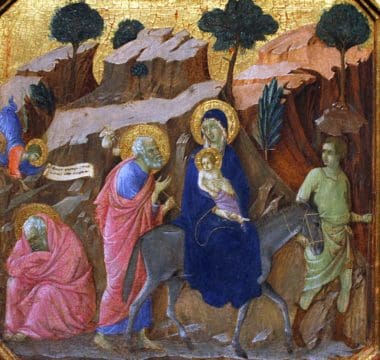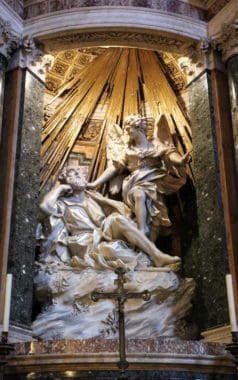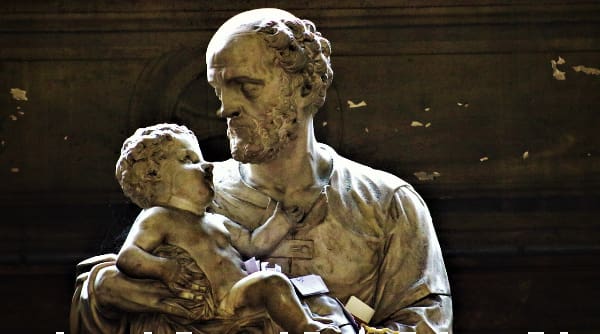Medieval writers did not diminish the importance of Joseph’s active life even as they praised his meditative nature. St. Bernard highlighted the humility of this descendant of kings who did not scorn manual work to support his family, and, even more poignantly, he invited his listeners to visualize Joseph permitted by God “to carry Him in His arms, rear Him, embrace Him, kiss Him, nourish and watch over Him.” St. Benedict had founded his order in the sixth century on the premise of ora et labora, “pray and work,” so it seems appropriate that the Benedictine reformer would be the first to explore the life of prayer that fueled Joseph’s love and labor.
A singular work by Sienese artist Duccio di Buoninsegna (1255–1319) illustrates this duality of Joseph’s ministry. In 1308, the city of Siena commissioned an extraordinary altarpiece, called the Maestà, in honor of the Blessed Virgin, the protectress of the town. Sixteen feet high, it was covered with seventy-five painted panels illustrating the lives of Christ and saints. The breathtaking painting has since been dismantled and several panels lost, but the surviving image of the Flight to Egypt demonstrates Duccio’s innovative iconography. Joseph is depicted twice in the seventeen inch – square space: first, on the far left, cocooned inside his cloak and fast asleep as an angel comes to warn him to “take the child and his mother, and flee to Egypt” (Matt. 2:13). Immediately to the right, Joseph appears again, fully alert, duly packed, with their meager possessions over his shoulder, shepherding his family away from danger. Most remarkably, the ever-silent Joseph seems to be speaking. With his open hand gesticulating to indicate speech and his intent gaze toward the face of the Virgin, he seems to be explaining the reasons for their hurried departure. Images of Joseph urgently ushering the Holy Family had started appearing in Tuscany during the thirteenth century: the mosaics of the Florentine Baptistery and a panel by Guido da Siena from about 1260 both suggest a speaking Joseph, but Duccio’s juxtaposition of the contemplative Joseph and the active Joseph was completely new.

Flight to Egypt by Duccio di Buoninsegna
In Duccio’s work, the apparent tension between the active and the contemplative life finds in Joseph an ideal harmony that is possible only for those who possess the perfection of charity. St. John Paul II, writing Redemptoris Custos in 1989, noted that St. Augustine distinguished between the love of the truth (caritas veritatis) and the practical demands of love (necessitas caritatis), proposing that Joseph “experienced both love of the truth — that pure contemplative love of the divine Truth which radiated from the humanity of Christ — and the demands of love — that equally pure and selfless love required for his vocation to safeguard and develop the humanity of Jesus, which was inseparably linked to his divinity.”

Dream of Joseph by Domenico Guidi
This image of Joseph would enjoy a revival in the sixteenth century thanks to contemplative Discalced Carmelites, whose art patronage would often focus on Joseph and his dreams. In the Carmelite Church of Santa Maria della Vittoria in Rome, built in 1620, Sleeping Joseph finally became the subject of an elaborately carved altarpiece, occupying the prestigious transept chapel across from Gian Lorenzo Bernini’s St. Teresa in Ecstasy. Bernini’s artistic competitor, Domenico Guidi (1625–1701), sculpted the work, which sadly, and not for lack of ambition, often goes overlooked in comparison with its more exuberant neighbor. Guidi attempted to convey the same sense of mystical weightlessness that Bernini had so perfectly executed in St. Teresa, shaping the marble foundation into a softly swelling mass, reminiscent of a pillow. But whereas Bernini’s Teresa is self-contained, her ecstatic moment enclosed in a defined architectural space, in Guidi’s work, the angel tugs and points, urging Joseph to wake and act. If the vision of St. Teresa signifies the preview of the sleep of death and the promise of Heaven, Joseph’s dream foretells the awakening to his mission.
In the immediately succeeding centuries, however, Joseph would find himself increasingly called away from his meditations to take a greater role in caring for the human needs of Christ.
+
This article is adapted from a chapter in The Silent Knight by Elizabeth Lev which is available from Sophia Institute Press.
Art for this post: Cover and featured image used with permission.






